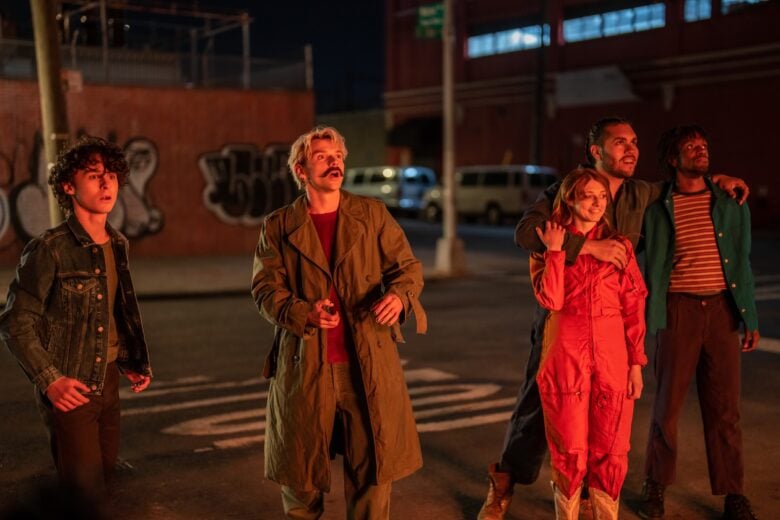 New drama City on Fire is here to shake up the Apple TV+ lineup. Set in New York City in 2003, it’s a twisty, coincidence-laden tale of a girl killed in Central Park. It focuses on an interconnected web of people who want to know what happened and why, as well as suspects who want the world to forget about her death.
New drama City on Fire is here to shake up the Apple TV+ lineup. Set in New York City in 2003, it’s a twisty, coincidence-laden tale of a girl killed in Central Park. It focuses on an interconnected web of people who want to know what happened and why, as well as suspects who want the world to forget about her death.
With its sprawling depiction of crime and the NYC music scene, City on Fire looks like a coin toss: a qualified success or an interesting misfire. Either way, this one’s worth a watch.
This post contains affiliate links. Cult of Mac may earn a commission when you use our links to buy items.
City on Fire season one opener recap
Season 1, episodes 1, 2 and 3: It’s the Fourth of July, 2003, in New York City, and someone’s been shot in Central Park. Her name is Samantha (played by Chase Sui Wonders). Though Samantha had many friends, there were no witnesses to her attempted killing.
Let’s start with her friends. Charlie (Wyatt Oleff), who went to high school with Samantha, ran into her while in the city for therapy (his dad died on 9/11). He and Sam struck up a friendship, but it ended abruptly after he got grounded for getting drunk with her, shortly before her death. (He realized he was mourning his dad through his relationship with her.) So when Samantha dies, he’s transfixed by the mystery.
Then there’s Keith (Ashley Zukerman), with whom Samantha was having an affair. Keith was married to Regan (Jemima Kirke), but she broke it off with him when she discovered his infidelity. Before she split, she left word with Mercer (Xavier Clyde), a mutual acquaintance of her brother, William (Nico Tortorella), to find her.
Acquaintance is the wrong word, actually. William is sleeping with Mercer, who’s a teacher at Regan and Keith’s kid’s school. William, a drug addict, has cut Regan out of his life. Also, he was the singer in Samantha’s favorite band.
A cast of characters, and a fateful party
And then we have Sewer (Alexandra Doke) and Sol (Alexander Pineiro), the wannabe guerillas Sam hung out with who were friends with William’s old bandmates. They stole explosive materials from Samantha’s dad’s workplace. She gets worried about what they plan to do with their haul, and calls Keith to warn him. However, he won’t speak to her because he still blames her for his marriage breaking up. So she tries to meet him at his Fourth of July party uptown, a party William ditches to go see his band play with their new lead singer, Nicky (Max Milner).
Mercer does end up at the party. He even sees Sam waiting outside before going in alone and getting high with a particularly feisty Regan, who’s smarting over the absence of both her brother and her husband. Mercer’s headed home later when he hears Samantha screaming in the park. He calls the police, and when they show up, they find William’s drugs on him and take him in, even if he doesn’t seem like much of a suspect in the murder.
It’s not like it’s cut-and-dried to detectives McFadden (Kathleen Munroe) and Parsa (Omid Abtahi) who shot Samantha, either.
That’s exactly what my mom would worry about

Photo: Apple TV+
City on Fire is a curious one. So, first things first, it’s based on a doorstop of a novel by Garth Risk Hellberg chronicling the lives of New Yorkers during the blackout of 1977. The book was pointedly Dickensian, linking the rich and the poor, the anarchists and the capitalists. New York in 1977 supported such a climate, because it was essentially ungoverned, poor and hungry and desperate, but creative and undaunted. That moment gave us punk rock and Robert Mapplethorpe, Keith Haring and CBGB.
The book’s 1977 setting has been transposed to 2003 by showrunners Josh Schwartz and Stephanie Savage. They worked on TV shows like The O.C. back then, and shortly after turned Gossip Girl into a phenomenon.
Now … if, like me, you have a certain affection (read: rabid obsession) with the art of New York in the ’70s and the people who were there to experience it like Lucy Sante, John Cale, Gary Indiana, Fran Lebowitz, Molly Haskell, Martin Scorsese, John Lurie and Greg Tate … switching the time period seems like a loaded decision.
On the one hand, I doubt this crew would have done 1970s New York justice because, frankly, not even Scorsese’s Vinyl managed to nail the feeling that still emanates from that period in images, words, notes and sounds. On the other hand, it feels like a bit of a cop-out to not spend the money to do it. Why adapt the book in the first place if not to take advantage of the possibilities inherent in its dense pages?
Capturing the 2003 NYC scene
Moving City on Fire to 2003 is also a little fraught for me, because that was when I was just getting into all the music on this show’s soundtrack. I wasn’t in New York for that period except as a frequent visitor, but I had all of those albums memorized and could pick those guys out of police lineups or outdoor brunches.
The Yeah Yeah Yeahs, The Rapture, The Strokes, TV On The Radio, The Walkmen, Ambulance Ltd., The Fever, my beloved Interpol … these bands meant more to me than the names of my classmates, and I only had eight of those for a few years. (I went to a hippie school.) I grew up knowing some of these bands and a lot of their former cohorts — the kinds of people who held their hair while they puked after shows. Getting dizzyingly close to that energy can feel like getting high for the first time, and I’m frequently grateful I didn’t get closer.
Anyway, the City on Fire team doesn’t do the best job capturing what it felt like to go to shows and live through this period. (There’s a documentary called Meet Me in the Bathroom, based on a book of the same name, that will let you know, if you’re curious and weren’t there, what it was like to be in the inner circle of those bands.) However, the new Apple TV+ drama is an admirable attempt to translate that dynamic scene for an audience weaned on Gossip Girl.
A couple of stumbles, but some definite potential
Things start a little rough. There’s a pretty inexcusable montage of Charlie grieving his father, with audio from 9/11 playing in the background and his dad calling him and saying he won’t be coming home. “My dad died last September,” Charlie tells Samantha, rather than just saying, “My dad died on 9/11.” Pretty bad.
Also, no one in 2003 talked like anyone in this show does. Not the punks, not the adults at cocktail parties, not the squirrely squares on the fringes of every scene. I knew them, I witnessed them, I was them. It’s all way too modern — the idioms and the body language and the stuttering, uncertain speech patterns. Plus, the show’s crooked landlord riff out of the Donald Trump playbook turns into second-hand Succession, but it’s just not as interesting as the HBO hit. (I haven’t even mentioned John Cameron Mitchell, who plays a conniving businessman, so Byzantine is the City on Fire plot).
This is how a TV show can be better than a novel

Photo: Apple TV+
The good news is there’s good news. In his review of the book in The New Yorker, Louis Menand said of the narrative’s crisscrossing coincidences: “It’s all highly implausible, of course. Contrary to what newcomers to the city may imagine, New York is a place where circles almost never intersect, except transactionally—at co-op meetings and parent-teacher conferences, or on jury duty. New Yorkers circulate mostly within their own class and occupational orbits. Manhattan is a hundred small towns unevenly distributed over some twenty-two square miles of city space.”
The Apple TV+ version of City on Fire alleviates this problem by virtue of being a TV show. It’s less conspicuous when you’re introduced to a dozen characters and then they happen to share a narrative.
The performances are mostly good, though Jemima Kirke wins MVP in her role as Regan, an Upper East Side housewife on the edge. I didn’t watch Girls when it was new, so had no real frame of reference for her acting, but she strikes me as the person most alive under the trappings of their character in this show.
I had a ton of reservations when City on Fire started, but I’m willing to give the show a shot, so everybody’s doing something right.
★★★☆☆
Watch City on Fire on Apple TV+
The first three episodes City on Fire premiered today on Apple TV+, with new episodes arriving every Friday.
Rated: TV-MA
Watch on: Apple TV+
Scout Tafoya is a film and TV critic, director and creator of the long-running video essay series The Unloved for RogerEbert.com. He has written for The Village Voice, Film Comment, The Los Angeles Review of Books and Nylon Magazine. He is the author of Cinemaphagy: On the Psychedelic Classical Form of Tobe Hooper and But God Made Him A Poet: Watching John Ford in the 21st Century, the director of 25 feature films, and the director and editor of more than 300 video essays, which can be found at Patreon.com/honorszombie.
![City on Fire tries to capture the heat of NYC in 2003 [Apple TV+ recap] Episode 3. Chase Sui Wonders in](https://www.cultofmac.com/wp-content/uploads/2023/05/City_On_Fire_Photo_010302-1536x1024.jpeg)


